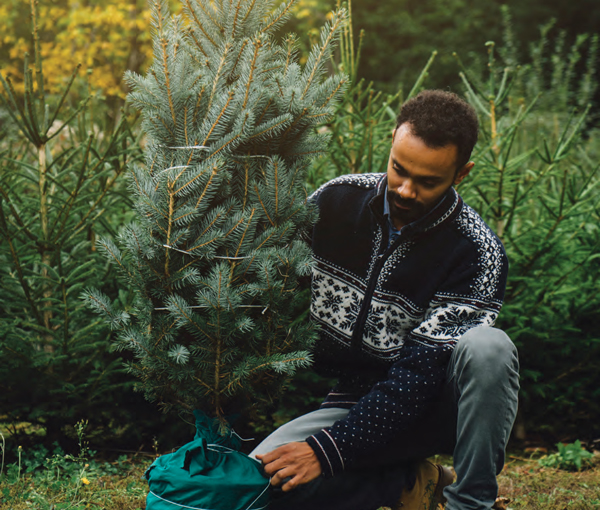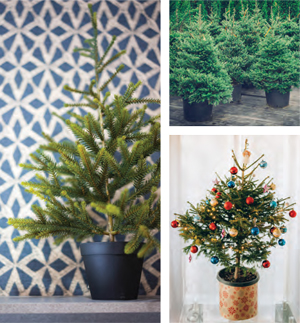Living Christmas Trees | A New Tradition

There are many trends sweeping across the country which allow us to do our part to help preserve and protect the environment. Solar panels on our rooftops, bees in our backyards and rain barrels by our homes are growing in popularity. One trend you may not have heard of is a living Christmas tree. You may be thinking, I’ve had a live tree for years. But there is a difference between a live tree, which is cut down and eventually dies, and a living tree that we can continue to enjoy long after the holidays are over.
Potted trees
Living Christmas trees can be purchased in two different ways. The first is to buy a tree which comes planted in a container. Garden stores usually carry a range of sizes and prices. A small potted tree is a great option for someone with limited space, as it can be displayed on a tabletop or tucked in a nook. It’s also a great idea if you are looking to simplify your holiday decorating, or if you want to add a second tree in a different part of your home. And, it’s a safe choice if you are traveling for the holidays and don’t want to leave your tree inside while you are gone. The risk of fire is real when it comes to traditional live trees, and a potted tree can easily be moved outside to a sheltered spot before you leave town.
Watering will be important, since a potted tree can dry out quickly, especially in indoor heat. If you plan to keep your tree potted beyond the winter, you may need to replant it into a larger container next spring. And because the roots are above ground, they will need more protection from the cold weather when you eventually move your tree outside.
Burlapped trees
The second option for a living tree is known as balled and burlapped. The tree is harvested with the soil and roots intact, so when you get it home it can easily be placed in a container, like a galvanized tub or decorative bucket, and put on display for the holidays. The larger the tree, the heavier the root ball, so a smaller tree may be easier to handle for some buyers. A balled and burlapped tree is easy to plant in your garden, and can add a dimension to your holiday that was not there in previous years. Planting a tree allows you to enjoy it year after year, and continue to make memories after the holidays by caring for the tree and watching it grow. If you have children at home or grandchildren visiting, this is a great way to teach them about nature and their environment. You can show them how a new addition to your landscaping will provide a home and food for wildlife. Some communities will even accept donated trees that can be planted in local parks or green spaces. These trees can be dedicated to a friend, family member or community leader that has a special place in your heart. This is a great way to honor someone who has made a difference in your life and the lives of others.
 Choosing your tree
Choosing your tree
If you plan to plant your living tree in your garden later, make sure you choose one that will grow well on your property. It’s a good idea to have a spot in mind before purchasing; your local nursery can provide guidance based on your soil type and the sun exposure. Be aware of how large the tree will get when it reaches full maturity when picking your spot—you want to make sure it will thrive when grown.
Even though we may have a picture in our minds of a large beautifully decorated tree in our homes, it may be wise to choose a smaller tree, which will handle the stress of moving from outside to inside better than a larger one. Be sure to choose a tree that is healthy—look for good color, needle retention, flexible branches, moist roots, and check that it is free of pests, critters and diseases.
Transitioning your tree
The success of your living tree depends on how you transition it from the cold weather outside to the indoors, and back outside again. A cooler place is better for your living tree, so choose a spot away from a direct source of heat. If the tree gets too warm and stays inside too long, it won’t stay dormant and might start to grow again, which will damage it when it returns to the outdoors. Try to move the tree back outside after about ten days. If it’s a potted living tree, a sheltered spot is best, and don’t forget to water it during warmer spells.
If you know in advance you’re going to buy and plant a balled and burlapped tree, it’s smart to dig the hole where you want to plant it ahead of time, before the ground freezes. Save the soil in your basement or garage to keep it warm. It’s also a good idea to transition your burlapped tree gently by placing it in a garage or carport for a couple of days before bringing it inside. Keep the roots damp but not soaked with water. You may want to spray it with an anti-desiccant to prevent it from drying out while it is inside. Use the same process to reacclimate your tree to the outside as when you brought it into your home, keeping it in a covered area for a few days before you plant it. A general rule of thumb for digging is to dig a hole that is twice as wide as your root ball but not any deeper. A living tree that is cared for and planted properly can be enjoyed for many seasons.
New traditions are a wonderful way to add something special to our holiday. A living Christmas tree has many benefits, but perhaps the most important benefit will be the memories we can make with our friends and families now and for years to come. ✦
balled tree, Burlapped trees, garden, live Christmas trees, Potted Trees






